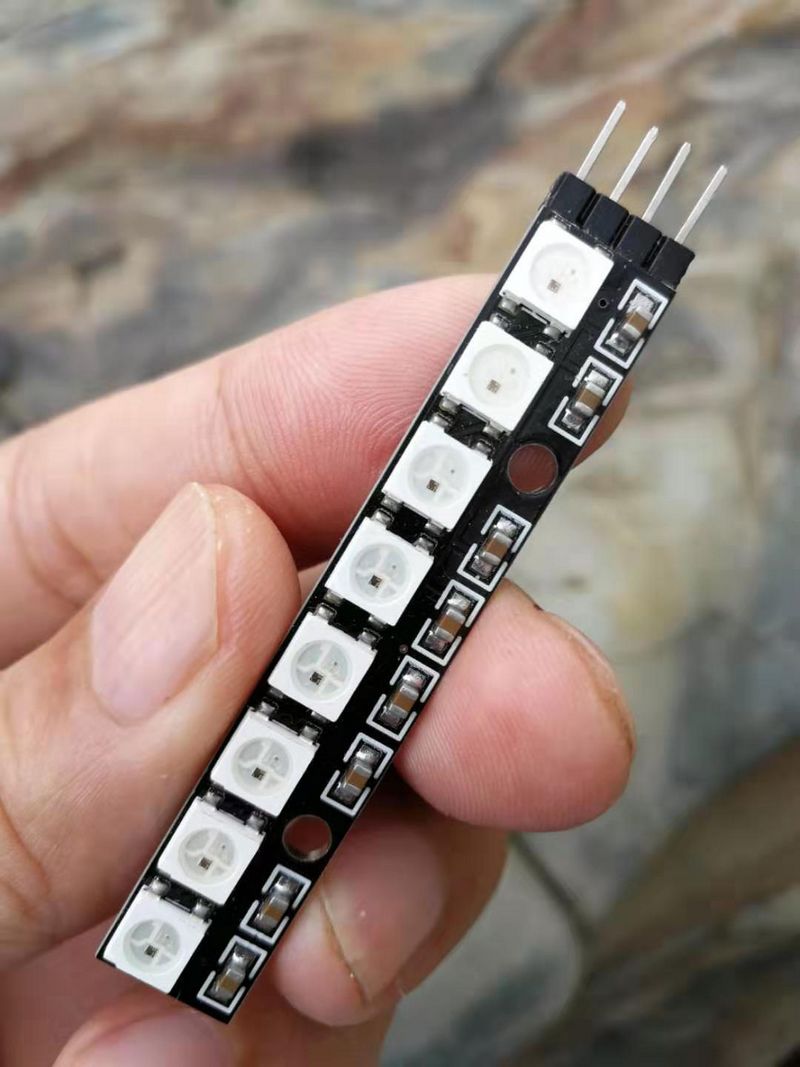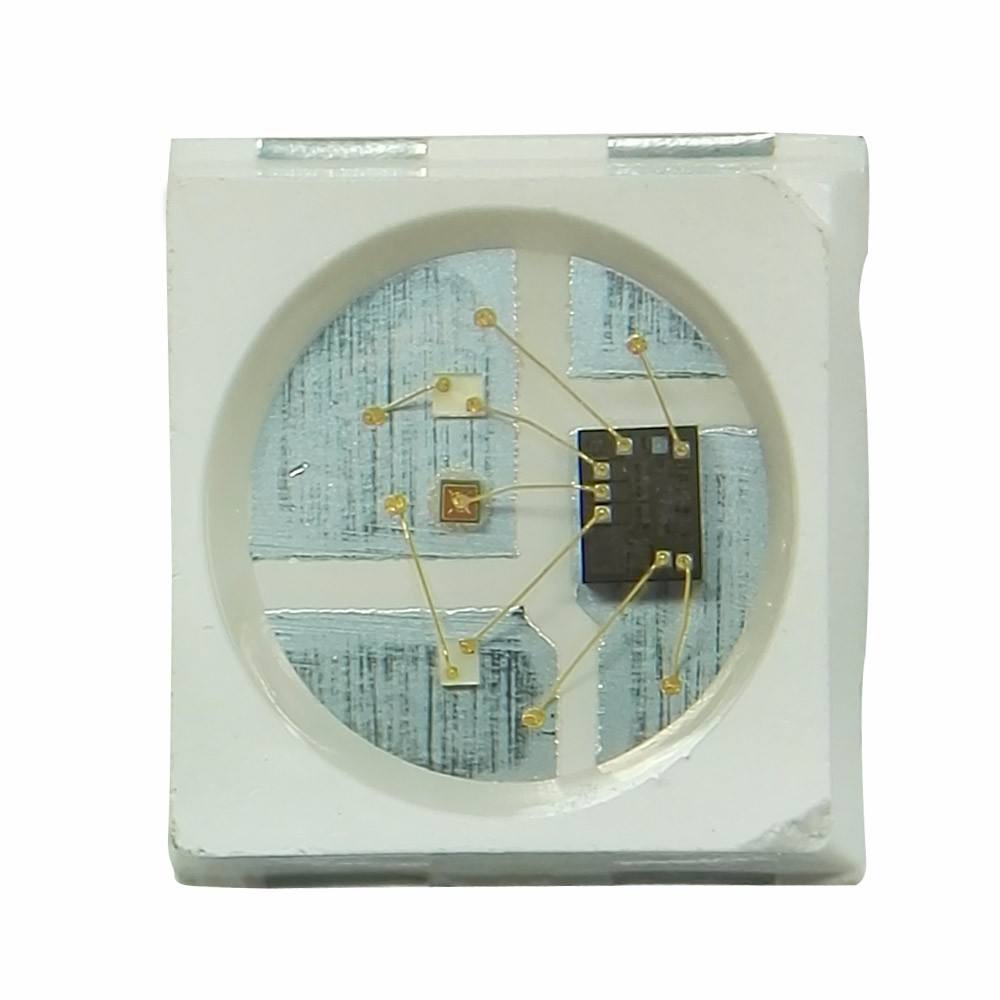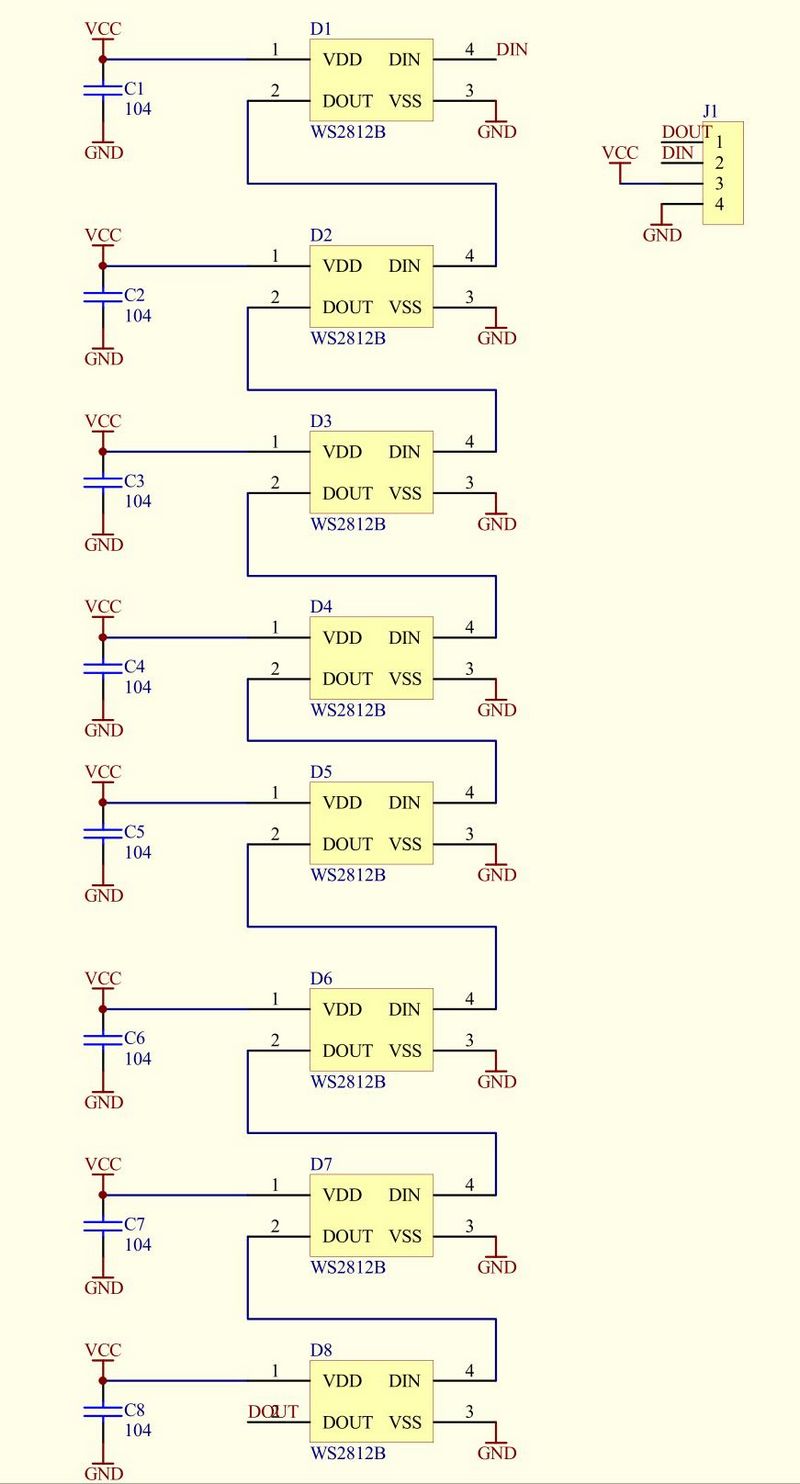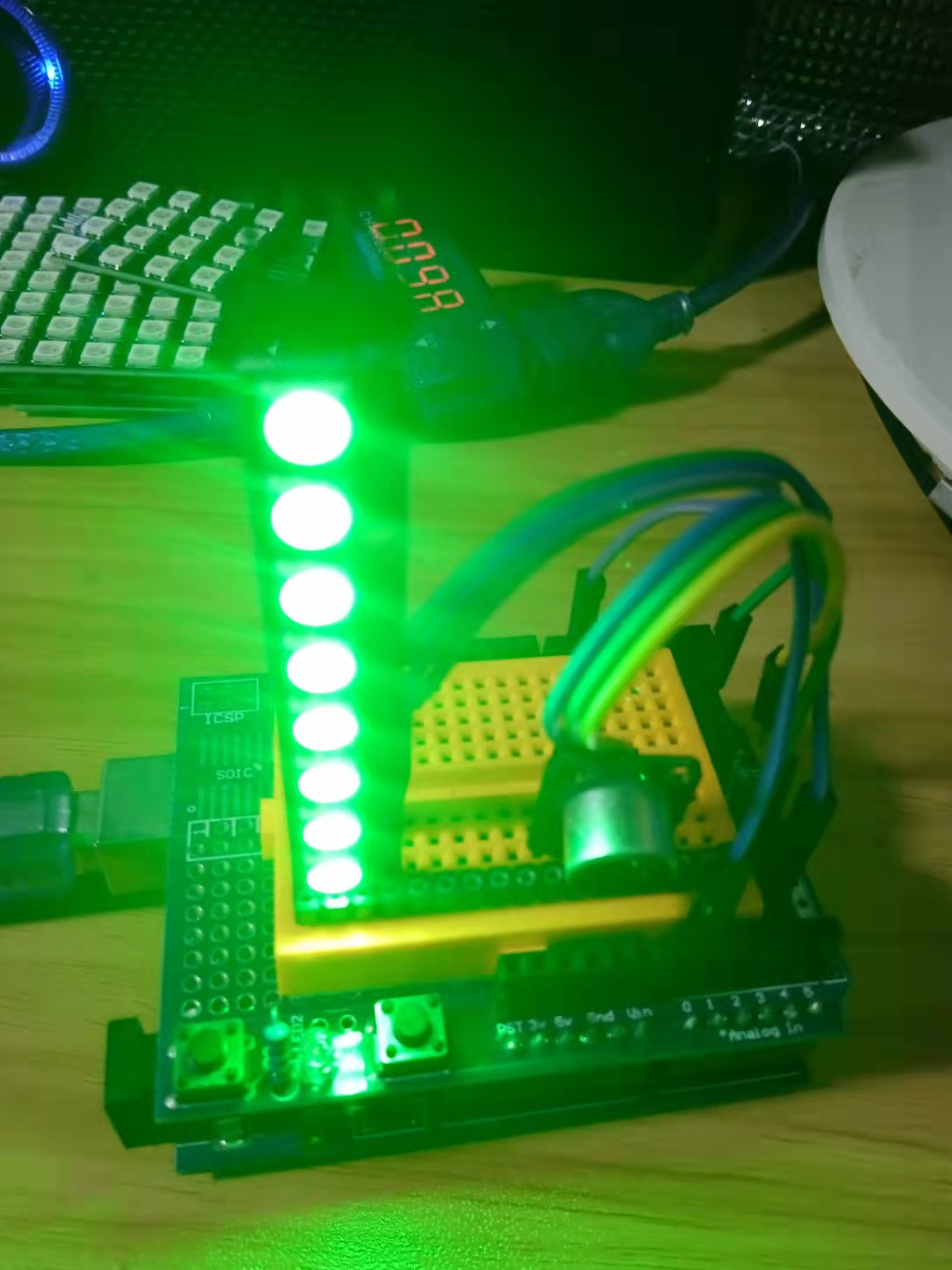37款传感器与执行器的提法,在网络上广泛流传,其实Arduino能够兼容的传感器模块肯定是不止这37种的。鉴于本人手头积累了一些传感器和执行器模块,依照实践出真知(一定要动手做)的理念,以学习和交流为目的,这里准备逐一动手尝试系列实验,不管成功(程序走通)与否,都会记录下来—小小的进步或是搞不掂的问题,希望能够抛砖引玉。
【Arduino】168种传感器模块系列实验(资料代码+仿真编程+图形编程)
实验六十: 直条8位 WS2812B 5050 RGB LED内置全彩驱动彩灯模块

知识点:WS2812B芯片
是一个集控制电路与发光电路于一体的智能外控LED光源。其外型与一个5050LED灯珠相同,每个元件即为一个像素点。像素点内部包含了智能数字接口数据锁存信号整形放大驱动电路,还包含有高精度的内部振荡器和12V高压可编程定电流控制部分,有效保证了像素点光的颜色高度一致。数据协议采用单线归零码的通讯方式,像素点在上电复位以后,DIN端接受从控制器传输过来的数据,首先送过来的24bit数据被第一个像素点提取后,送到像素点内部的数据锁存器,剩余的数据经过内部整形处理电路整形放大后通过DO端口开始转发输出给下一个级联的像素点,每经过一个像素点的传输,信号减少24bit。像素点采用自动整形转发技术,使得该像素点的级联个数不受信号传送的限制,仅仅受限信号传输速度要求。

WS2812主要特点
1、智能反接保护,电源反接不会损坏IC。
2、IC控制电路与LED点光源公用一个电源。
3、控制电路与RGB芯片集成在一个5050封装的元器件中,构成一个完整的外控像素点。
4、内置信号整形电路,任何一个像素点收到信号后经过波形整形再输出,保证线路波形畸变不会累加。
5、内置上电复位和掉电复位电路。
6、每个像素点的三基色颜色可实现256级亮度显示,完成16777216种颜色的全真色彩显示,扫描频率不低于400Hz/s。
7、串行级联接口,能通过一根信号线完成数据的接收与解码。
8、任意两点传传输距离在不超过5米时无需增加任何电路。
9、当刷新速率30帧/秒时,级联数不小于1024点。
10、数据发送速度可达800Kbps。
11、光的颜色高度一致,性价比高。

【Arduino】168种传感器模块系列实验(资料代码+图形编程+仿真编程)
实验六十: 直条8位 WS2812B 5050 RGB LED内置全彩驱动彩灯模块
项目十七:FastLED“100行代码”演示卷轴动画效果
实验开源代码
/*
【Arduino】168种传感器模块系列实验(资料代码+图形编程+仿真编程)
实验六十一: 直条8位 WS2812B 5050 RGB LED内置全彩驱动彩灯模块
项目十七:FastLED“100行代码”演示卷轴动画效果
*/
#include <FastLED.h>
FASTLED_USING_NAMESPACE
// FastLED "100-lines-of-code" demo reel, showing just a few
// of the kinds of animation patterns you can quickly and easily
// compose using FastLED.
//
// This example also shows one easy way to define multiple
// animations patterns and have them automatically rotate.
//
// -Mark Kriegsman, December 2014
#define DATA_PIN 5
//#define CLK_PIN 4
#define LED_TYPE WS2811
#define COLOR_ORDER GRB
#define NUM_LEDS 8
CRGB leds[NUM_LEDS];
#define BRIGHTNESS 33
#define FRAMES_PER_SECOND 120
void setup() {
delay(3000); // 3 second delay for recovery
// tell FastLED about the LED strip configuration
FastLED.addLeds<LED_TYPE, DATA_PIN, COLOR_ORDER>(leds, NUM_LEDS).setCorrection(TypicalLEDStrip);
//FastLED.addLeds<LED_TYPE,DATA_PIN,CLK_PIN,COLOR_ORDER>(leds, NUM_LEDS).setCorrection(TypicalLEDStrip);
// set master brightness control
FastLED.setBrightness(BRIGHTNESS);
}
// List of patterns to cycle through. Each is defined as a separate function below.
typedef void (*SimplePatternList[])();
SimplePatternList gPatterns = { rainbow, rainbowWithGlitter, confetti, sinelon, juggle, bpm };
uint8_t gCurrentPatternNumber = 0; // Index number of which pattern is current
uint8_t gHue = 0; // rotating "base color" used by many of the patterns
void loop()
{
// Call the current pattern function once, updating the 'leds' array
gPatterns[gCurrentPatternNumber]();
// send the 'leds' array out to the actual LED strip
FastLED.show();
// insert a delay to keep the framerate modest
FastLED.delay(1000 / FRAMES_PER_SECOND);
// do some periodic updates
EVERY_N_MILLISECONDS( 20 ) {
gHue++; // slowly cycle the "base color" through the rainbow
}
EVERY_N_SECONDS( 10 ) {
nextPattern(); // change patterns periodically
}
}
#define ARRAY_SIZE(A) (sizeof(A) / sizeof((A)[0]))
void nextPattern()
{
// add one to the current pattern number, and wrap around at the end
gCurrentPatternNumber = (gCurrentPatternNumber + 1) % ARRAY_SIZE( gPatterns);
}
void rainbow()
{
// FastLED's built-in rainbow generator
fill_rainbow( leds, NUM_LEDS, gHue, 7);
}
void rainbowWithGlitter()
{
// built-in FastLED rainbow, plus some random sparkly glitter
rainbow();
addGlitter(80);
}
void addGlitter( fract8 chanceOfGlitter)
{
if ( random8() < chanceOfGlitter) {
leds[ random16(NUM_LEDS) ] += CRGB::White;
}
}
void confetti()
{
// random colored speckles that blink in and fade smoothly
fadeToBlackBy( leds, NUM_LEDS, 10);
int pos = random16(NUM_LEDS);
leds[pos] += CHSV( gHue + random8(64), 200, 255);
}
void sinelon()
{
// a colored dot sweeping back and forth, with fading trails
fadeToBlackBy( leds, NUM_LEDS, 20);
int pos = beatsin16( 13, 0, NUM_LEDS - 1 );
leds[pos] += CHSV( gHue, 255, 192);
}
void bpm()
{
// colored stripes pulsing at a defined Beats-Per-Minute (BPM)
uint8_t BeatsPerMinute = 62;
CRGBPalette16 palette = PartyColors_p;
uint8_t beat = beatsin8( BeatsPerMinute, 64, 255);
for ( int i = 0; i < NUM_LEDS; i++) { //9948
leds[i] = ColorFromPalette(palette, gHue + (i * 2), beat - gHue + (i * 10));
}
}
void juggle() {
// eight colored dots, weaving in and out of sync with each other
fadeToBlackBy( leds, NUM_LEDS, 20);
uint8_t dothue = 0;
for ( int i = 0; i < 8; i++) {
leds[beatsin16( i + 7, 0, NUM_LEDS - 1 )] |= CHSV(dothue, 200, 255);
dothue += 32;
}
} 【Arduino】168种传感器模块系列实验(资料代码+图形编程+仿真编程)
实验六十: 直条8位 WS2812B 5050 RGB LED内置全彩驱动彩灯模块
项目十八:随机60帧火焰花
实验开源代码
/*
【Arduino】168种传感器模块系列实验(资料代码+图形编程+仿真编程)
实验六十一: 直条8位 WS2812B 5050 RGB LED内置全彩驱动彩灯模块
项目十八:随机60帧火焰花
*/
#include <FastLED.h>
#define LED_PIN 5
#define COLOR_ORDER GRB
#define CHIPSET WS2811
#define NUM_LEDS 8
#define BRIGHTNESS 36
#define FRAMES_PER_SECOND 60
bool gReverseDirection = false;
CRGB leds[NUM_LEDS];
void setup() {
delay(3000); // sanity delay
FastLED.addLeds<CHIPSET, LED_PIN, COLOR_ORDER>(leds, NUM_LEDS).setCorrection( TypicalLEDStrip );
FastLED.setBrightness( BRIGHTNESS );
}
void loop()
{
// Add entropy to random number generator; we use a lot of it.
// random16_add_entropy( random());
Fire2012(); // run simulation frame
FastLED.show(); // display this frame
FastLED.delay(1000 / FRAMES_PER_SECOND);
}
// Fire2012 by Mark Kriegsman, July 2012
// as part of "Five Elements" shown here: http://youtu.be/knWiGsmgycY
////
// This basic one-dimensional 'fire' simulation works roughly as follows:
// There's a underlying array of 'heat' cells, that model the temperature
// at each point along the line. Every cycle through the simulation,
// four steps are performed:
// 1) All cells cool down a little bit, losing heat to the air
// 2) The heat from each cell drifts 'up' and diffuses a little
// 3) Sometimes randomly new 'sparks' of heat are added at the bottom
// 4) The heat from each cell is rendered as a color into the leds array
// The heat-to-color mapping uses a black-body radiation approximation.
//
// Temperature is in arbitrary units from 0 (cold black) to 255 (white hot).
//
// This simulation scales it self a bit depending on NUM_LEDS; it should look
// "OK" on anywhere from 20 to 100 LEDs without too much tweaking.
//
// I recommend running this simulation at anywhere from 30-100 frames per second,
// meaning an interframe delay of about 10-35 milliseconds.
//
// Looks best on a high-density LED setup (60+ pixels/meter).
//
//
// There are two main parameters you can play with to control the look and
// feel of your fire: COOLING (used in step 1 above), and SPARKING (used
// in step 3 above).
//
// COOLING: How much does the air cool as it rises?
// Less cooling = taller flames. More cooling = shorter flames.
// Default 50, suggested range 20-100
#define COOLING 55
// SPARKING: What chance (out of 255) is there that a new spark will be lit?
// Higher chance = more roaring fire. Lower chance = more flickery fire.
// Default 120, suggested range 50-200.
#define SPARKING 120
void Fire2012()
{
// Array of temperature readings at each simulation cell
static uint8_t heat[NUM_LEDS];
// Step 1. Cool down every cell a little
for( int i = 0; i < NUM_LEDS; i++) {
heat[i] = qsub8( heat[i], random8(0, ((COOLING * 10) / NUM_LEDS) + 2));
}
// Step 2. Heat from each cell drifts 'up' and diffuses a little
for( int k= NUM_LEDS - 1; k >= 2; k--) {
heat[k] = (heat[k - 1] + heat[k - 2] + heat[k - 2] ) / 3;
}
// Step 3. Randomly ignite new 'sparks' of heat near the bottom
if( random8() < SPARKING ) {
int y = random8(7);
heat[y] = qadd8( heat[y], random8(160,255) );
}
// Step 4. Map from heat cells to LED colors
for( int j = 0; j < NUM_LEDS; j++) {
CRGB color = HeatColor( heat[j]);
int pixelnumber;
if( gReverseDirection ) {
pixelnumber = (NUM_LEDS-1) - j;
} else {
pixelnumber = j;
}
leds[pixelnumber] = color;
}
} 【Arduino】168种传感器模块系列实验(资料代码+图形编程+仿真编程)
实验六十: 直条8位 WS2812B 5050 RGB LED内置全彩驱动彩灯模块
项目十九:带有可编程调色板的 Fire2012 火灾模拟
实验开源代码
/*
【Arduino】168种传感器模块系列实验(资料代码+图形编程+仿真编程)
实验六十一: 直条8位 WS2812B 5050 RGB LED内置全彩驱动彩灯模块
项目十九:带有可编程调色板的 Fire2012 火灾模拟
*/
#include <FastLED.h>
#define LED_PIN 5
#define COLOR_ORDER GRB
#define CHIPSET WS2811
#define NUM_LEDS 8
#define BRIGHTNESS 32
#define FRAMES_PER_SECOND 60
bool gReverseDirection = false;
CRGB leds[NUM_LEDS];
// Fire2012 with programmable Color Palette
//
// This code is the same fire simulation as the original "Fire2012",
// but each heat cell's temperature is translated to color through a FastLED
// programmable color palette, instead of through the "HeatColor(...)" function.
//
// Four different static color palettes are provided here, plus one dynamic one.
//
// The three static ones are:
// 1. the FastLED built-in HeatColors_p -- this is the default, and it looks
// pretty much exactly like the original Fire2012.
//
// To use any of the other palettes below, just "uncomment" the corresponding code.
//
// 2. a gradient from black to red to yellow to white, which is
// visually similar to the HeatColors_p, and helps to illustrate
// what the 'heat colors' palette is actually doing,
// 3. a similar gradient, but in blue colors rather than red ones,
// i.e. from black to blue to aqua to white, which results in
// an "icy blue" fire effect,
// 4. a simplified three-step gradient, from black to red to white, just to show
// that these gradients need not have four components; two or
// three are possible, too, even if they don't look quite as nice for fire.
//
// The dynamic palette shows how you can change the basic 'hue' of the
// color palette every time through the loop, producing "rainbow fire".
CRGBPalette16 gPal;
void setup() {
delay(3000); // sanity delay
FastLED.addLeds<CHIPSET, LED_PIN, COLOR_ORDER>(leds, NUM_LEDS).setCorrection( TypicalLEDStrip );
FastLED.setBrightness( BRIGHTNESS );
// This first palette is the basic 'black body radiation' colors,
// which run from black to red to bright yellow to white.
gPal = HeatColors_p;
// These are other ways to set up the color palette for the 'fire'.
// First, a gradient from black to red to yellow to white -- similar to HeatColors_p
// gPal = CRGBPalette16( CRGB::Black, CRGB::Red, CRGB::Yellow, CRGB::White);
// Second, this palette is like the heat colors, but blue/aqua instead of red/yellow
// gPal = CRGBPalette16( CRGB::Black, CRGB::Blue, CRGB::Aqua, CRGB::White);
// Third, here's a simpler, three-step gradient, from black to red to white
// gPal = CRGBPalette16( CRGB::Black, CRGB::Red, CRGB::White);
}
void loop()
{
// Add entropy to random number generator; we use a lot of it.
random16_add_entropy( random());
// Fourth, the most sophisticated: this one sets up a new palette every
// time through the loop, based on a hue that changes every time.
// The palette is a gradient from black, to a dark color based on the hue,
// to a light color based on the hue, to white.
//
// static uint8_t hue = 0;
// hue++;
// CRGB darkcolor = CHSV(hue,255,192); // pure hue, three-quarters brightness
// CRGB lightcolor = CHSV(hue,128,255); // half 'whitened', full brightness
// gPal = CRGBPalette16( CRGB::Black, darkcolor, lightcolor, CRGB::White);
Fire2012WithPalette(); // run simulation frame, using palette colors
FastLED.show(); // display this frame
FastLED.delay(1000 / FRAMES_PER_SECOND);
}
// Fire2012 by Mark Kriegsman, July 2012
// as part of "Five Elements" shown here: http://youtu.be/knWiGsmgycY
////
// This basic one-dimensional 'fire' simulation works roughly as follows:
// There's a underlying array of 'heat' cells, that model the temperature
// at each point along the line. Every cycle through the simulation,
// four steps are performed:
// 1) All cells cool down a little bit, losing heat to the air
// 2) The heat from each cell drifts 'up' and diffuses a little
// 3) Sometimes randomly new 'sparks' of heat are added at the bottom
// 4) The heat from each cell is rendered as a color into the leds array
// The heat-to-color mapping uses a black-body radiation approximation.
//
// Temperature is in arbitrary units from 0 (cold black) to 255 (white hot).
//
// This simulation scales it self a bit depending on NUM_LEDS; it should look
// "OK" on anywhere from 20 to 100 LEDs without too much tweaking.
//
// I recommend running this simulation at anywhere from 30-100 frames per second,
// meaning an interframe delay of about 10-35 milliseconds.
//
// Looks best on a high-density LED setup (60+ pixels/meter).
//
//
// There are two main parameters you can play with to control the look and
// feel of your fire: COOLING (used in step 1 above), and SPARKING (used
// in step 3 above).
//
// COOLING: How much does the air cool as it rises?
// Less cooling = taller flames. More cooling = shorter flames.
// Default 55, suggested range 20-100
#define COOLING 55
// SPARKING: What chance (out of 255) is there that a new spark will be lit?
// Higher chance = more roaring fire. Lower chance = more flickery fire.
// Default 120, suggested range 50-200.
#define SPARKING 120
void Fire2012WithPalette()
{
// Array of temperature readings at each simulation cell
static uint8_t heat[NUM_LEDS];
// Step 1. Cool down every cell a little
for( int i = 0; i < NUM_LEDS; i++) {
heat[i] = qsub8( heat[i], random8(0, ((COOLING * 10) / NUM_LEDS) + 2));
}
// Step 2. Heat from each cell drifts 'up' and diffuses a little
for( int k= NUM_LEDS - 1; k >= 2; k--) {
heat[k] = (heat[k - 1] + heat[k - 2] + heat[k - 2] ) / 3;
}
// Step 3. Randomly ignite new 'sparks' of heat near the bottom
if( random8() < SPARKING ) {
int y = random8(7);
heat[y] = qadd8( heat[y], random8(160,255) );
}
// Step 4. Map from heat cells to LED colors
for( int j = 0; j < NUM_LEDS; j++) {
// Scale the heat value from 0-255 down to 0-240
// for best results with color palettes.
uint8_t colorindex = scale8( heat[j], 240);
CRGB color = ColorFromPalette( gPal, colorindex);
int pixelnumber;
if( gReverseDirection ) {
pixelnumber = (NUM_LEDS-1) - j;
} else {
pixelnumber = j;
}
leds[pixelnumber] = color;
}
} 【Arduino】168种传感器模块系列实验(资料代码+图形编程+仿真编程)
实验六十: 直条8位 WS2812B 5050 RGB LED内置全彩驱动彩灯模块
项目二十:快速移动单个白色 LED
实验开源代码
/*
【Arduino】168种传感器模块系列实验(资料代码+图形编程+仿真编程)
实验六十一: 直条8位 WS2812B 5050 RGB LED内置全彩驱动彩灯模块
项目二十:快速移动单个白色 LED
*/
// Use if you want to force the software SPI subsystem to be used for some reason (generally, you don't)
// #define FASTLED_FORCE_SOFTWARE_SPI
// Use if you want to force non-accelerated pin access (hint: you really don't, it breaks lots of things)
// #define FASTLED_FORCE_SOFTWARE_SPI
// #define FASTLED_FORCE_SOFTWARE_PINS
#include <FastLED.h>
///////////////////////////////////////////////////////////////////////////////////////////
//
// Move a white dot along the strip of leds. This program simply shows how to configure the leds,
// and then how to turn a single pixel white and then off, moving down the line of pixels.
//
// How many leds are in the strip?
#define NUM_LEDS 8
// For led chips like WS2812, which have a data line, ground, and power, you just
// need to define DATA_PIN. For led chipsets that are SPI based (four wires - data, clock,
// ground, and power), like the LPD8806 define both DATA_PIN and CLOCK_PIN
// Clock pin only needed for SPI based chipsets when not using hardware SPI
#define DATA_PIN 5
//#define CLOCK_PIN 13
// This is an array of leds. One item for each led in your strip.
CRGB leds[NUM_LEDS];
// This function sets up the ledsand tells the controller about them
void setup() {
// sanity check delay - allows reprogramming if accidently blowing power w/leds
FastLED.setBrightness(26);
delay(2000);
// Uncomment/edit one of the following lines for your leds arrangement.
// ## Clockless types ##
// FastLED.addLeds<NEOPIXEL, DATA_PIN>(leds, NUM_LEDS); // GRB ordering is assumed
// FastLED.addLeds<SM16703, DATA_PIN, RGB>(leds, NUM_LEDS);
// FastLED.addLeds<TM1829, DATA_PIN, RGB>(leds, NUM_LEDS);
// FastLED.addLeds<TM1812, DATA_PIN, RGB>(leds, NUM_LEDS);
// FastLED.addLeds<TM1809, DATA_PIN, RGB>(leds, NUM_LEDS);
// FastLED.addLeds<TM1804, DATA_PIN, RGB>(leds, NUM_LEDS);
// FastLED.addLeds<TM1803, DATA_PIN, RGB>(leds, NUM_LEDS);
// FastLED.addLeds<UCS1903, DATA_PIN, RGB>(leds, NUM_LEDS);
// FastLED.addLeds<UCS1903B, DATA_PIN, RGB>(leds, NUM_LEDS);
// FastLED.addLeds<UCS1904, DATA_PIN, RGB>(leds, NUM_LEDS);
// FastLED.addLeds<UCS2903, DATA_PIN, RGB>(leds, NUM_LEDS);
// FastLED.addLeds<WS2812, DATA_PIN, RGB>(leds, NUM_LEDS); // GRB ordering is typical
// FastLED.addLeds<WS2852, DATA_PIN, RGB>(leds, NUM_LEDS); // GRB ordering is typical
// FastLED.addLeds<WS2812B, DATA_PIN, RGB>(leds, NUM_LEDS); // GRB ordering is typical
// FastLED.addLeds<GS1903, DATA_PIN, RGB>(leds, NUM_LEDS);
// FastLED.addLeds<SK6812, DATA_PIN, RGB>(leds, NUM_LEDS); // GRB ordering is typical
// FastLED.addLeds<SK6822, DATA_PIN, RGB>(leds, NUM_LEDS);
// FastLED.addLeds<APA106, DATA_PIN, RGB>(leds, NUM_LEDS);
// FastLED.addLeds<PL9823, DATA_PIN, RGB>(leds, NUM_LEDS);
// FastLED.addLeds<SK6822, DATA_PIN, RGB>(leds, NUM_LEDS);
FastLED.addLeds<WS2811, DATA_PIN, RGB>(leds, NUM_LEDS);
// FastLED.addLeds<WS2813, DATA_PIN, RGB>(leds, NUM_LEDS);
// FastLED.addLeds<APA104, DATA_PIN, RGB>(leds, NUM_LEDS);
// FastLED.addLeds<WS2811_400, DATA_PIN, RGB>(leds, NUM_LEDS);
// FastLED.addLeds<GE8822, DATA_PIN, RGB>(leds, NUM_LEDS);
// FastLED.addLeds<GW6205, DATA_PIN, RGB>(leds, NUM_LEDS);
// FastLED.addLeds<GW6205_400, DATA_PIN, RGB>(leds, NUM_LEDS);
// FastLED.addLeds<LPD1886, DATA_PIN, RGB>(leds, NUM_LEDS);
// FastLED.addLeds<LPD1886_8BIT, DATA_PIN, RGB>(leds, NUM_LEDS);
// ## Clocked (SPI) types ##
// FastLED.addLeds<LPD6803, DATA_PIN, CLOCK_PIN, RGB>(leds, NUM_LEDS); // GRB ordering is typical
// FastLED.addLeds<LPD8806, DATA_PIN, CLOCK_PIN, RGB>(leds, NUM_LEDS); // GRB ordering is typical
// FastLED.addLeds<WS2801, DATA_PIN, CLOCK_PIN, RGB>(leds, NUM_LEDS);
// FastLED.addLeds<WS2803, DATA_PIN, CLOCK_PIN, RGB>(leds, NUM_LEDS);
// FastLED.addLeds<SM16716, DATA_PIN, CLOCK_PIN, RGB>(leds, NUM_LEDS);
// FastLED.addLeds<P9813, DATA_PIN, CLOCK_PIN, RGB>(leds, NUM_LEDS); // BGR ordering is typical
// FastLED.addLeds<DOTSTAR, DATA_PIN, CLOCK_PIN, RGB>(leds, NUM_LEDS); // BGR ordering is typical
// FastLED.addLeds<APA102, DATA_PIN, CLOCK_PIN, RGB>(leds, NUM_LEDS); // BGR ordering is typical
// FastLED.addLeds<SK9822, DATA_PIN, CLOCK_PIN, RGB>(leds, NUM_LEDS); // BGR ordering is typical
}
// This function runs over and over, and is where you do the magic to light
// your leds.
void loop() {
// Move a single white led
for (int whiteLed = 0; whiteLed < NUM_LEDS; whiteLed = whiteLed + 1) {
// Turn our current led on to white, then show the leds
leds[whiteLed] = CRGB::White;
// Show the leds (only one of which is set to white, from above)
FastLED.show();
// Wait a little bit
delay(100);
// Turn our current led back to black for the next loop around
leds[whiteLed] = CRGB::Black;
}
} 【Arduino】168种传感器模块系列实验(资料代码+图形编程+仿真编程)
实验六十: 直条8位 WS2812B 5050 RGB LED内置全彩驱动彩灯模块
项目二十一: 使用多个控制器示例(多个 LED 阵列不同工作模式可调)
实验开源代码
/*
【Arduino】168种传感器模块系列实验(资料代码+图形编程+仿真编程)
实验六十: 直条8位 WS2812B 5050 RGB LED内置全彩驱动彩灯模块
项目二十一: 使用多个控制器示例(多个 LED 阵列不同工作模式可调)
*/
// MirroringSample - see https://github.com/FastLED/FastLED/wiki/Multiple-Controller-Examples for more info on
// using multiple controllers. In this example, we're going to set up four NEOPIXEL strips on four
// different pins, and show the same thing on all four of them, a simple bouncing dot/cyclon type pattern
#include <FastLED.h>
#define NUM_LEDS_PER_STRIP 8
CRGB leds[NUM_LEDS_PER_STRIP];
// For mirroring strips, all the "special" stuff happens just in setup. We
// just addLeds multiple times, once for each strip
void setup() {
// tell FastLED there's 60 NEOPIXEL leds on pin 4
FastLED.addLeds<NEOPIXEL, 4>(leds, NUM_LEDS_PER_STRIP);
// tell FastLED there's 60 NEOPIXEL leds on pin 5
FastLED.addLeds<NEOPIXEL, 5>(leds, NUM_LEDS_PER_STRIP);
// tell FastLED there's 60 NEOPIXEL leds on pin 6
FastLED.addLeds<NEOPIXEL, 6>(leds, NUM_LEDS_PER_STRIP);
// tell FastLED there's 60 NEOPIXEL leds on pin 7
FastLED.addLeds<NEOPIXEL, 7>(leds, NUM_LEDS_PER_STRIP);
}
void loop() {
for(int i = 0; i < NUM_LEDS_PER_STRIP; i++) {
// set our current dot to red
leds[i] = CRGB::Red;
FastLED.show();
// clear our current dot before we move on
leds[i] = CRGB::Black;
delay(100);
}
for(int i = NUM_LEDS_PER_STRIP-1; i >= 0; i--) {
// set our current dot to red
leds[i] = CRGB::Red;
FastLED.show();
// clear our current dot before we move on
leds[i] = CRGB::Black;
delay(100);
}
} 【Arduino】168种传感器模块系列实验(资料代码+图形编程+仿真编程)
实验六十: 直条8位 WS2812B 5050 RGB LED内置全彩驱动彩灯模块
项目二十二: 在三个 NEOPIXEL 条上设置三个不同的管脚,
每个条都有自己的 CRGB 数组来播放
实验开源代码
/*
【Arduino】168种传感器模块系列实验(资料代码+图形编程+仿真编程)
实验六十一: 直条8位 WS2812B 5050 RGB LED内置全彩驱动彩灯模块
项目二十二: 在三个 NEOPIXEL 条上设置三个不同的管脚,
每个条都有自己的 CRGB 数组来播放
*/
// MultiArrays - see https://github.com/FastLED/FastLED/wiki/Multiple-Controller-Examples for more info on
// using multiple controllers. In this example, we're going to set up three NEOPIXEL strips on three
// different pins, each strip getting its own CRGB array to be played with
#include <FastLED.h>
#define NUM_LEDS_PER_STRIP 8
CRGB redLeds[NUM_LEDS_PER_STRIP];
CRGB greenLeds[NUM_LEDS_PER_STRIP];
CRGB blueLeds[NUM_LEDS_PER_STRIP];
// For mirroring strips, all the "special" stuff happens just in setup. We
// just addLeds multiple times, once for each strip
void setup() {
// tell FastLED there's 60 NEOPIXEL leds on pin 10
FastLED.addLeds<NEOPIXEL, 4>(redLeds, NUM_LEDS_PER_STRIP);
// tell FastLED there's 60 NEOPIXEL leds on pin 11
FastLED.addLeds<NEOPIXEL, 5>(greenLeds, NUM_LEDS_PER_STRIP);
// tell FastLED there's 60 NEOPIXEL leds on pin 12
FastLED.addLeds<NEOPIXEL, 6>(blueLeds, NUM_LEDS_PER_STRIP);
}
void loop() {
for(int i = 0; i < NUM_LEDS_PER_STRIP; i++) {
// set our current dot to red, green, and blue
redLeds[i] = CRGB::Red;
greenLeds[i] = CRGB::Green;
blueLeds[i] = CRGB::Blue;
FastLED.show();
// clear our current dot before we move on
redLeds[i] = CRGB::Black;
greenLeds[i] = CRGB::Black;
blueLeds[i] = CRGB::Black;
delay(100);
}
for(int i = NUM_LEDS_PER_STRIP-1; i >= 0; i--) {
// set our current dot to red, green, and blue
redLeds[i] = CRGB::Red;
greenLeds[i] = CRGB::Green;
blueLeds[i] = CRGB::Blue;
FastLED.show();
// clear our current dot before we move on
redLeds[i] = CRGB::Black;
greenLeds[i] = CRGB::Black;
blueLeds[i] = CRGB::Black;
delay(100);
}
}Arduino实验场景图


 返回首页
返回首页
 回到顶部
回到顶部


9mm2023.08.10
666